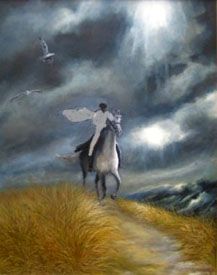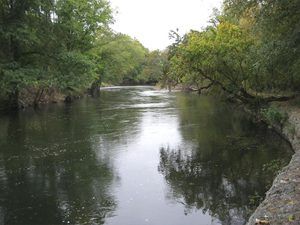By Charles M. Skinner, 1896
The height that rises a mile or so to the south of Newark, Delaware, is called Iron Hill because it is rich in hematite ore. But about the time of General William Howe’s advance to the Brandywine River, it might well have won its name because of the panoply of war — the sullen guns, the flashing swords, and glistening bayonets — that appeared among the British tents pitched on it.
After the red-coats had established a camp here, the American outposts were advanced, and one of the pickets was stationed at Welsh Tract Church. On his first tour of duty, the sentry was thrown into great alarm by the appearance of a figure robed from head to foot in white riding a horse at a charging gait within ten feet of his face. When the guard was relieved, the soldier begged that he never be assigned to that post again. His nerves were strong in the presence of an enemy in the flesh — but an enemy out of the grave! Ugh! He would desert rather than encounter that shape again. His request was granted.
The sentry who succeeded him was startled, in the small hours, by a rush of hoofs and the flash of a pallid form. He fired at it and thought that he heard the sound of a mocking laugh come back.

White horse
Every night the phantom horseman made his rounds, and several times the sentinels shot at him without effect, the white horse and white rider showing no annoyance at these assaults.
When it came to the turn of a skeptical and unimaginative old corporal to take the night detail, he took the liberty of assuming the responsibilities of this post himself. He looked well to the priming of his musket, and at midnight withdrew out of the moonshine and waited, with his gun resting on a fence. It was not long before the beat of hoofs was heard approaching, and despite himself, the corporal felt a thrill along his spine as a mounted figure that might have represented Death on the pale horse came into view. Still, he jammed his hat down, set his teeth, and sighted his flint-lock with deliberation.
The rider was near when bang went the corporal’s musket, and a white form was lying in the road, a horse speeding into the distance. Scrambling over the fence, the corporal reassured, ran to the form and turned it over: a British scout, quite dead. The daring fellow, relying on the superstitious fears of the rustics in his front, had made a nightly ride as a ghost to keep the American outposts from advancing and also to guess, from elevated points, at the strength and disposition of their troops. He wore a cuirass of steel, but that did not protect his brain from the corporal’s bullet.
Compiled & edited by Kathy Weiser-Alexander/Legends of America, updated June 2021.
Also See:
Legends, Myths & Tales of the Native Americans
About the Author: Charles M. Skinner (1852-1907) authored the complete nine-volume set of Myths and Legends of Our Own Land in 1896. This tale is excerpted from these excellent works, which are now in the public domain.

